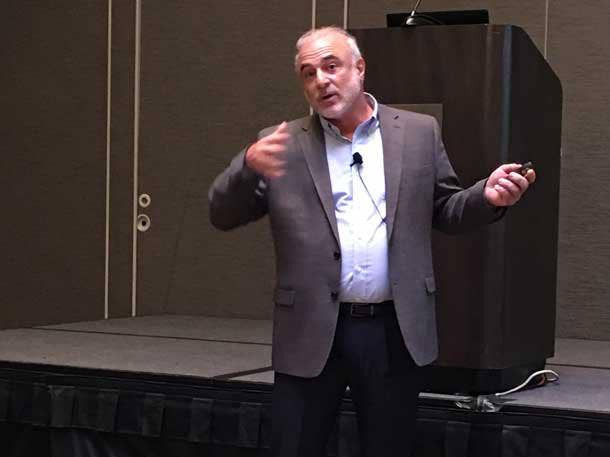Gartner Analyst: Cost Optimization Key To Better IT Management On Smaller Budgets

Joe Provenza, research director for analyst firm Gartner, told an audience of CIOs and IT administrators at this week's Midsize Enterprise Summit that IT leaders are being forced to focus on cost optimization to deal with IT budgets that never seem to keep up with requirements.
The Midsize Enterprise Summit, held this week in San Diego, is hosted by CRN parent The Channel Company.
IT leaders have to deal with the fact that there's little they can do with the resources they are given unless they look at better ways to use those resources, Provenza said.
[Related: Gartner Analyst: Everyone Needs To Be On The Same Page When Defining A Midsize Enterprise]
"There's [a lot of] chess pieces that don't move on the board," he said. "We have smaller budgets. … There's only one chess piece on the board we can move, and it's us."
Gartner, in a recent study, found that 72 percent of an IT budget is typically spent on running the IT, compared to only 18 percent spent on growing a company's business and 10 percent on transforming that business, which Provenza said is backward from what it should be.
Before looking at how to improve cost optimization, Provenza dispelled three common misconceptions about what cost optimization is.
First, he said, cutting budgets is not equal to cost optimization. "That just means we have less money in a space of time," he said.
Second, cutting staff is not equal to cost optimization. "That just means you have few people to do the job," he said.
Third, freezing budgets is not cost optimization, but is instead just an emergency measure. "It's something you sometimes have to do," he said.
Cost optimization includes several core concepts that CIOs and other IT leaders need to address, Provenza said.
The first is financial transparency, as it is impossible to know if one is spending too little or too much on services without it, he said. "And you have to know the future of your spending," he said.
One simple tool is to calculate the run rate forward, Provenza said. This is simply looking at how much was spent so far in a given year, divide it by the number of months already passed, and multiply that by 12, he said.
That, he said, will help make it easier to handle unexpected events. For instance, while IT leaders can't do much about phone, electricity, and similar costs, they may be able to react to unexpected events by immediately changing something they can control. "If you run into something, you can cut your travel budget," he said.
Another important way to improve financial transparency is to find a way to control shadow IT, or the ability for employees to purchase and use technology that is neither purchased by or approved by the IT department.
Provenza said anyone who does not know what is being spent can't optimize costs. "All you can do is throw money at the loudest voice," he said.
Another way to improve cost optimization is to standardize on fewer vendors and IT infrastructures, particularly via the adoption of utility-based infrastructure, Provenza said.
This could include the adoption of such technologies as firewall-as-a-service, disaster recovery-as-a-service, unified communications-as-a-service, hyper-converged infrastructures, micro data centers, and virtual machine backup and recovery, he said.
In technology, time is the best ally when it comes time to make IT purchases, and utility-based IT takes advantage of time, Provenza said. For example, a single solution that solves a major need may be too expensive now, but over time the price will fall.
"Time is your friend," he said. "Over time, tech gets bigger, better, and cheaper."
Security, which is the bane of many businesses, should also be treated as a service as much as possible, Provenza said.
A Gartner study found that 87 percent of midsize and small enterprises do not have dedicated security resources, but that can be more than made up by adopting security-based services on a that work on a 24x7 basis, he said.
"They don't do those annoying things employees do," he said. "They don't go home or eat or get sick."
While many businesses think cloud is a way to optimize costs, it may not be the best option, Provenza said. Where it does work best is when used to automate processes that have become routine, freeing staff up to develop new business, he said.
Taken together, the various ways to do cost optimization are critical to increasing IT efficiencies in a time when IT budgets may not keep up with requirements, Provenza said.
"This is how you do it," he said. "It's how you spend less on running the business, and more on growing it."
The IT manager of a luxury travel agency told CRN on condition of anonymity that his biggest take-away from Provenza's presentation is the need to better understand what other departments in the business are doing and how IT can help them.
"If IT knows what the departments are doing, they can help speed up processes," the IT manager said. "Sometimes there are too many cooks in the kitchen and not enough people focused on cost optimization."
The IT manager cited the problem of shadow IT as an area where it is important for IT departments to better maintain control.
"Think of Microsoft OneDrive vs. Dropbox," he said. "We have OneDrive because of our licenses. But people use Dropbox internally, and we don't know what they are doing."
Another way the IT manager sees to improve cost optimization is to help other departments consider contacting the IT department before making purchases. One example is equipment for making internal company presentations.
"We have the TVs and the other equipment to do presentations internally," he said. "But people still want to buy other equipment, or they don't know that we already have it."